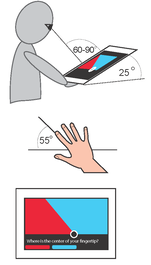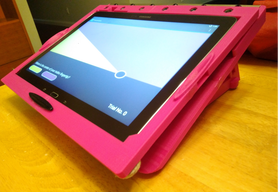Other projects
Example publication
Block, H.J., Mirdamadi, J.L., Ryckman, S., Wilson, R., Lynch, A.K., Udayan, D., Massie, C. (2019).
A tool for accurate measurement of proprioception in the clinical setting.
Journal of Neurologic Physical Therapy 43(2), 106-116. [PubMed]
Background and purpose: Proprioceptive deficits in the hand are common following stroke, but current clinical measurement techniques are too imprecise to detect subtle impairments or small changes. We developed a tablet-based tool to measure static hand proprioception using an adaptive staircase procedure.
Methods: In 16 individuals with chronic stroke and age-matched controls, we quantified proprioception at the metacarpophalangeal joint of the index finger using 3 methods: the tablet task, a custom passive movement direction discrimination test (PMDD), and a manual assessment similar to the Fugl-Meyer (F-M) proprioception subsection.
Results: The tablet-based measure and the PMDD both identified impaired proprioception in the affected hand relative to the unaffected hand (P = 0.024 and 0.028), and relative to the control group (P = 0.040 and 0.032), while manual assessment did not. The PMDD had a ceiling effect as movement excursions greater than 15 were not biomechanically feasible. The tablet-based measure and the PMDD detected impaired proprioception in 56% to 75%, and the F-M in only 29%, of patients. PMDD and tablet-based measures were both correlated with primary tactile sensation, but not manual dexterity.
Discussion and conclusions: Both the tablet-based tool and the custom PMDD performed better than manual assessment. The PMDD may be useful when the deficit is mild or assessment of dynamic proprioception is desired. As the tablet-based measure does not have the ceiling effect that is associated with the PMDD, it may be useful with any level of proprioceptive impairment, and may be preferable if testing or clinician training time needs to be minimized, or pain or spasticity is present.
A tool for accurate measurement of proprioception in the clinical setting.
Journal of Neurologic Physical Therapy 43(2), 106-116. [PubMed]
Background and purpose: Proprioceptive deficits in the hand are common following stroke, but current clinical measurement techniques are too imprecise to detect subtle impairments or small changes. We developed a tablet-based tool to measure static hand proprioception using an adaptive staircase procedure.
Methods: In 16 individuals with chronic stroke and age-matched controls, we quantified proprioception at the metacarpophalangeal joint of the index finger using 3 methods: the tablet task, a custom passive movement direction discrimination test (PMDD), and a manual assessment similar to the Fugl-Meyer (F-M) proprioception subsection.
Results: The tablet-based measure and the PMDD both identified impaired proprioception in the affected hand relative to the unaffected hand (P = 0.024 and 0.028), and relative to the control group (P = 0.040 and 0.032), while manual assessment did not. The PMDD had a ceiling effect as movement excursions greater than 15 were not biomechanically feasible. The tablet-based measure and the PMDD detected impaired proprioception in 56% to 75%, and the F-M in only 29%, of patients. PMDD and tablet-based measures were both correlated with primary tactile sensation, but not manual dexterity.
Discussion and conclusions: Both the tablet-based tool and the custom PMDD performed better than manual assessment. The PMDD may be useful when the deficit is mild or assessment of dynamic proprioception is desired. As the tablet-based measure does not have the ceiling effect that is associated with the PMDD, it may be useful with any level of proprioceptive impairment, and may be preferable if testing or clinician training time needs to be minimized, or pain or spasticity is present.


